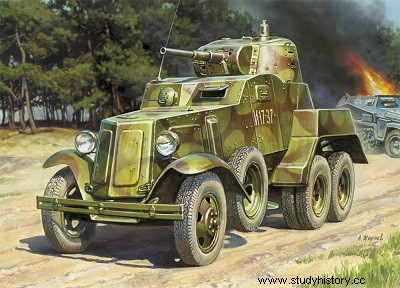
BA-10, BA-10ZhD and variants
Type: armored car.
Crew :4 men.
Armament: a 45 mm cannon; a coaxial 7.62 mm DT machine gun; a 7.62 mm DT machine gun in the hull (next to the driver).
Armour:
minimum 6 mm;
maximum 15mm.
Dimensions:
length: 4.65 m;
width: 2.07 m
height: 2.21 m.
Weight: 5 t
Ground pressure: 3.15 kg/cm2.
Power to weight: 9.8 bhp.
Engine: Model GAZ-M1 4 cyl. in-line water-cooled gasoline engine, developing 50 hp at 2,800 rpm.
Performance:
road speed: 55 km/h;
range: 300 km;
vertical obstacle: negligible;
straight cut: negligible;
slope: 20°.
Service time: in the Red Army from 1938 to 1943
From 1931, the Soviet automobile industry began to produce a series of six-wheeled armored cars for the Red Army. First there was the BA-27M (see text relating to the BA-27), followed, the same year, by the amphibious BAD and the D-13. None of these vehicles, however, went beyond the experimental stage. The first six-wheeled medium armored car adopted by the army was, in 1932, the BA-1. It was a 6x4, built at the lzhorsk plant and also known as BAI. It used the Ford-Timken truck chassis, imported from the United States.
A small series was built, varying its armament and a few other details, before moving on to the use of the GAZ-AAA six-wheeled chassis. In 1933 was created the BA-10 a 6x4, also built by lzhorsk. It was an improved BA-10 based on the GAZ-AAA chassis, armed with a 45mm cannon and a coaxial machine gun mounted in the turret of the T-26 light tank.
Special tracks could be placed around the rear wheels to improve off-road performance. The spare wheels, mounted on axles on the sides of the body, rotated freely to provide the vehicle with additional support when crossing obstacles.
This feature, as well as the spare tracks , was maintained for all these six-wheeled vehicles.
The BA-a retained as standard equipment for reconnaissance sub-units, remained in service until the beginning of the Second World War.
In 1935, the Russians created their first experimental amplified vehicle, a 6x4 armored car. It was the PB-4, which remained at the experimental stage. That same year, lzhorsk designed an improved BA-3 called BA-6. Three versions were produced, all adopted by the army:the BA-6 (1935), the BA-6ZhD (1935), intended to run on the railways, and the BA-6M (1936). All three took part in military operations from 1936 to 1939.
In 1936 appeared a modified version of the BA-6M, called BA-9. Built on the GAZ-AAA chassis, this vehicle differed from the previous ones in its weight and armament. Only a small series were built. It was in the same year that the Republican troops of Spain began to use standard six-wheeled armored cars.
In all the USSR sent them about 100 vehicles of this type. On the other hand, Russian engineers helped to prepare the construction of these vehicles in Spain itself, construction which became effective in 1937 and 1938.
In 1938, the Red Army adopted the BA-10 , which was a further improvement over the BA-9, and also designed by the design bureau of the lzhorsk plant. It was produced massively from 1938 to 1941. In addition to the basic model BA-10, the railway variant SA-10ZhD appeared in 1938. The BA-10, which became the standard equipment of reconnaissance units and independent armored brigades, remained in service until 1943.
All the armored cars then put into service took part in the battles not only in Spain, but also in Manchuria against the Japanese, during the Finnish-Soviet war and during the first phase of the German-Soviet war. Along with the series of medium six-wheeled armored cars, the Russians created several heavy six-wheeled models, including the famous amphibious BAZ, the gasoline BA-11 and the diesel BA-1LD, which also fought on the front of the East Many other variants of the six-wheeled armored vehicles were also built, including ambulances, tankers and troop carriers.
